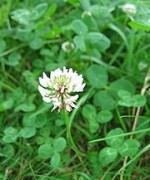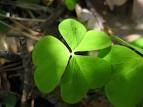|
|
|
|
Which is the shamrock? According to Wikipedia, they all could be. The first is Trilfoium repens (white clover), the second Medicago lupulina (Black Medick) and the third is Oxalis acetosella (wood Sorrel). There are other possibilities too. Originally, white clover was probably intended but perhaps because our grocery stores and garden centers have found Oxalis more sellable than clover the image of an Oxalis leaf has found its way into our mind as the icon of all that is Irish. So, what do we know about the shamrock, whatever plant it was or is?
 Irish myth tells us that St. Patrick used the shamrock to teach the Trinity to the Druids. The Celtic Druids revered the shamrock, called seamrog in Gaelic, because it had three leaves. They believed that the number “3” was sacred and had mystical powers. The number three influenced artistic motifs, as well as story telling, and religious thinking in Gaelic culture. The three leaves were associated with the image of many of the Celtic Gods and Goddesses such as the three Brigids and were believed to ward off evil spirits. The upward direction of its leaves were thought to foretell severe weather. (Such reverence for “3” is not unique to the Druids. Consider what else comes in three: the Greeks had three Fates, three Furies, and three Grace; nature has three states of matter, three primary colors, and three areas of the biosphere; and children’s literature has three bears, three little pigs, three blind mice; the list goes on.)
Irish myth tells us that St. Patrick used the shamrock to teach the Trinity to the Druids. The Celtic Druids revered the shamrock, called seamrog in Gaelic, because it had three leaves. They believed that the number “3” was sacred and had mystical powers. The number three influenced artistic motifs, as well as story telling, and religious thinking in Gaelic culture. The three leaves were associated with the image of many of the Celtic Gods and Goddesses such as the three Brigids and were believed to ward off evil spirits. The upward direction of its leaves were thought to foretell severe weather. (Such reverence for “3” is not unique to the Druids. Consider what else comes in three: the Greeks had three Fates, three Furies, and three Grace; nature has three states of matter, three primary colors, and three areas of the biosphere; and children’s literature has three bears, three little pigs, three blind mice; the list goes on.)
 St. Patrick is also credited with driving the snakes out of Ireland and Ireland lacks snakes even today. Legend says that St. Patrick planted shamrocks everywhere in Ireland to keep the snakes from returning but some people say that shamrocks grow everywhere that St. Patrick preached. Believers note that snakes are not seen in Ireland or anywhere else where shamrocks grows and that the shamrock is believed to be a remedy for snake venom.
St. Patrick is also credited with driving the snakes out of Ireland and Ireland lacks snakes even today. Legend says that St. Patrick planted shamrocks everywhere in Ireland to keep the snakes from returning but some people say that shamrocks grow everywhere that St. Patrick preached. Believers note that snakes are not seen in Ireland or anywhere else where shamrocks grows and that the shamrock is believed to be a remedy for snake venom.
 Unfortunately, these wonderful stories are probably not true. No mention is made of the shamrock in any of St. Patrick’s writings or those of his contemporaries. The first mention of the shamrock in regard to teaching the Trinity was 1727, over 1000 years after St. Patrick died. The story of St. Patrick driving the snakes out of Ireland probably is a metaphor for his driving out the old pagan religion of the Druids. But there may be some truth to these stories. The shamrock was a symbol found on many medieval bishops’ tombs, including St. Patrick’s and was found on the copper coins that were once known as “St. Patrick’s money”.
Unfortunately, these wonderful stories are probably not true. No mention is made of the shamrock in any of St. Patrick’s writings or those of his contemporaries. The first mention of the shamrock in regard to teaching the Trinity was 1727, over 1000 years after St. Patrick died. The story of St. Patrick driving the snakes out of Ireland probably is a metaphor for his driving out the old pagan religion of the Druids. But there may be some truth to these stories. The shamrock was a symbol found on many medieval bishops’ tombs, including St. Patrick’s and was found on the copper coins that were once known as “St. Patrick’s money”.
 But who cares if the stores are historically accurate or not? Most of us love legends and folktales and the stories of St. Patrick and the shamrock have added greatly to Irish lore and culture. The Shamrock was mentioned in 1681 as the badge to be worn on St. Patrick’s Feast Day. Wearing the shamrock grew in importance and after the Boer War in 1900 when Queen Victoria ordered that all ranks of her Irish regiments should wear a sprig of shamrock in their head dress to commemorate the bravery of the Irish soldiers in the Boer War. The shamrock is the official emblem on the airline of Ireland, Aer Lingus, and every year the airline flies freshly cut shamrocks to the Irish embassies all over the world on St. Patrick’s Day so that all Irish diplomats can “wear the green.”
But who cares if the stores are historically accurate or not? Most of us love legends and folktales and the stories of St. Patrick and the shamrock have added greatly to Irish lore and culture. The Shamrock was mentioned in 1681 as the badge to be worn on St. Patrick’s Feast Day. Wearing the shamrock grew in importance and after the Boer War in 1900 when Queen Victoria ordered that all ranks of her Irish regiments should wear a sprig of shamrock in their head dress to commemorate the bravery of the Irish soldiers in the Boer War. The shamrock is the official emblem on the airline of Ireland, Aer Lingus, and every year the airline flies freshly cut shamrocks to the Irish embassies all over the world on St. Patrick’s Day so that all Irish diplomats can “wear the green.”
 Going back, now, to the botanical and gardening aspects of clover, let’s get some facts about it as a plant. Clover is a great crop for improving the soil; it grows easily even with mowing, is good feed for livestock, and fixes nitrogen in the soil. Some people grow clover in lawns because it will grow well even when grass struggles.
Going back, now, to the botanical and gardening aspects of clover, let’s get some facts about it as a plant. Clover is a great crop for improving the soil; it grows easily even with mowing, is good feed for livestock, and fixes nitrogen in the soil. Some people grow clover in lawns because it will grow well even when grass struggles.
Whether you are a lover of plants, folklore, or all things Irish, the shamrock is a great plant.



